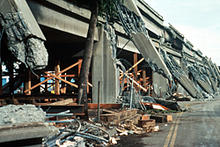Disaster Resilient Buildings and Infrastructure
(+$5 million)
Challenge

A large percentage of the nation's population is concentrated in areas prone to natural hazards, including hurricanes, extreme winds, storm surge, wildland fires, earthquakes, and tsunamis. U.S. communities also face a continuing threat from terrorist attacks, criminal activities, and technological accidents. Disasters in the United States are responsible for an estimated $55 billion in average annual costs in terms of lives lost, disruption of commerce and financial networks, properties destroyed, and the expense of mobilizing emergency response personnel and equipment.
The disaster resilience of our physical infrastructure and communities today is determined in large measure by the building standards, codes, and practices used when they were built. With few exceptions, these are oversimplified and inconsistent with respect to risk. As construction and rebuilding costs continue to rise, there is increasing recognition of the need to move from response and recovery to proactively identifying and mitigating hazards that pose the greatest threats.
Proposed NIST Program
The fundamental idea underpinning this initiative is that disaster resilience can be enhanced by developing a robust capability to predict and mitigate, rather than just respond to, the effects of natural and man-made hazards on the performance of complex structural systems.
Initiative funding in FY 2011 also will allow NIST to:
- create and maintain a National Disaster and Failure Events Database to serve as a public archival repository on natural and man-made hazard events, the performance of the built environment, the effectiveness of emergency response and evacuation procedures, and pre-disaster mitigation studies specific to hazard events; and
- develop the capability to test the performance of real-scale structures under realistic fire and structural loading at the National Structural Fire Resistance Laboratory (NSFRL) currently under construction at NIST's Gaithersburg, Md., campus; and
- conduct experiments in the NSFRL to develop an experimental database on the performance of large-scale structural connections, components, subassemblies, and systems under realistic fire and loading conditions for validation of predictive models.
Expected Impacts
This initiative addresses five of the six Grand Challenges1 identified by the National Science and Technology Council for advancing science and technology to enhance the nation's disaster resilience. They are:
- provide hazard and disaster information where and when it is needed;
- understand the natural processes that produce hazards;
- develop hazard mitigation strategies and technologies;
- assess disaster resilience using standard methods; and
- promote risk-wise behavior.
Specifically, this initiative will help prevent hazards (e.g., earthquakes, hurricanes, and community-scale fires) from becoming disasters by increasing the disaster resilience of the nation's buildings and infrastructure. The need for response and recovery will be minimized through proactive identification of hazards that pose threats, enabling action to mitigate their potential consequences. The expected impacts of this program will be achieved by:
- advancing the ability to predict building and infrastructure performance in disaster situations;
- enabling the improvement of emergency response and evacuation procedures, and pre-disaster mitigation plans specific to hazard events;
- widely disseminating data, models, and guidelines that yield improvements in standards, codes, and practices;
- enabling the transformation from prescriptive to performance-based design of buildings and infrastructure for fire resistance; and
- enhancing the safety of buildings, infrastructure, emergency responders, and the public at large across the nation.
1 National Science and Technology Council, Committee on Environmental and Natural Resources, Subcommittee on Disaster Reduction, Grand Challenges for Disaster Reduction, June 2005, p.21.

